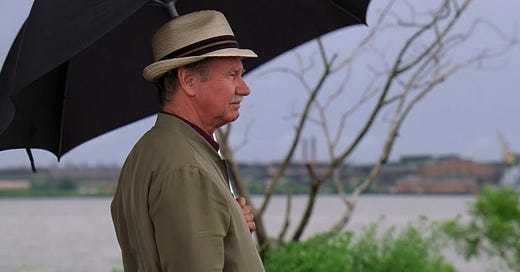
Competing Realities (with Kathryn Cramer Brownell)
Cable news, narrowcasting, and alternate-reality TV.
Time was, there were just three broadcast networks: CBS, NBC, and ABC (which had been spawned from NBC, like Eve from Adam’s rib). When the Second World War broke out, there weren’t that many TV sets. Invented by Philo T. Farnsworth in 1927, the television had only existed for a decade and a half. Radio was the primary non-print media. By the end of the 1940s, after an explosion in popularity, TV viewership was approaching the critical mass it would achieve during the 1952 presidential campaign. I like Ike, but I love TV.
Because there were so few networks, and all of them were competing for the same vast pool of viewers, programming had to be as small-c catholic as possible. Mass appeal was the name of the game. The broadcast networks’ mission was contained in that very word: broadcast.
“The broadcasting and Hollywood studio eras were a time when news and entertainment producers looked to appeal to the broadest audience possible,” writes the history professor Kathryn Cramer Brownell, my guest on today’s PREVAIL podcast, in her excellent new book, 24/7 Politics: Cable Television and the Fragmenting of America from Watergate to Fox News. “Performance and stagecraft mattered, of course, but so too did an ability to connect to a wide range of people.”
Back in the day, a news anchor, always a middle-aged white man, delivered the nightly news. His was the voice of authority. There were advantages to this model. Because there were so few alternative networks, the newscaster had to stick to the facts. Walter Cronkite—the Most Trusted Man in America—would never have gone on air and said an election that wasn’t stolen was stolen, or flat-out lied about vaccine efficacy, or made a big stink out of LBJ’s dog biting a Secret Service agent. Edward R. Morrow did not, as far as I know, file a single report about the War on Christmas.
But there were drawbacks, too. The casting wasn’t that broad. Programming was tailored exclusively to suburban white middle-class audiences. Newsrooms were the province of white men. Women and people of color were excluded. Anyone gay had to be in the closet.
Cable television changed that. More channels meant more variety, more diversity, more programming: more inclusivity. Broadcasters found that by targeting smaller but more loyal audiences, they could make bank. So that’s what they did—with the results we see today. “The shift to niche and narrowcasting programming on the cable dial,” as Brownell writes, “created a media world that prioritized cult followings and fealty to individual brands.”
24/7 Politics lays out this shift in meticulous detail, providing context and nuance to the most well-known moments when media and politics most visibly intersected. Nixon didn’t suck at the debate with JFK because he underestimated the importance of TV; he was trying to present as a more serious, sober alternative to the gleaming Camelot guy, and lacked the charm to pull it off. The alleged “liberal media bias,” always a myth, emerged in the early 60s, when Southern politicians demanding equal time complained that there wasn’t enough pro-segregation content on the airwaves. A lot of the much-bashed deregulation that happened during the Reagan administration was actually [adjusts tie, moves head nervously back and forth] the result of policies first implemented under Carter. Fox News, a station that now specializes in white male grievance, came into being because angry white male Roger Ailes, spurned during the creation of MSNBC, had an axe to grind. And so on. It is a rich, fascinating history, well told in Brownell’s book.
“If you think about network television, you had a shared experience, a shared set of facts that people were consuming,” Brownell tells me. “The problem, though, is that it was not all of the facts, right? There were so many different perspectives that were excluded. And there’s a reliance on just official sources, and really it adheres to those who are in power. So, again, it’s a tricky situation. You decentralize the media, you allow for the diversity of new voices that can advance social change and racial justice—all of these things—but then you also open up these other voices that can come to play, that are manipulating and advancing lies.”
This happens online, too, of course. In the elections of 2016 and 2020, Twitter was a robust, vital news source—the narrowcasting was so narrow, you could choose it yourself. By following the right sources—the verification system helped stem the flow of fake news—you could quickly, easily, and efficiently know what was going on, anywhere in the world. Many journalists have lately taken to Substack, another model of narrowcasting. When these tools are properly curated, you can know a lot more about a lot more things than you can by just reading the New York Times or watching CNN. But how to curate? That is the question. When new media is subverted and destroyed—X’ed out, you might say—by South African emerald scions in league with the world’s fascists, and this otherwise lovely publishing platform allows chaos agents to publish slander and lies without repercussion because FREE SPEECH, the whole media ecosystem becomes a jumbled mess. Where is Walter Cronkite when you need him?
Even the cable news channels, which should be more even-keeled than social media and online newsletters and blogs, differ vastly in what they present. “It’s just a stark difference,” Brownell says. “If you go from CNN to MSNBC to Fox News, especially in 2020 during and after the election, it was—you couldn’t recognize the information that was being conveyed to viewers. And it was really striking, and it really cemented and confirmed what I had found in my research about these echo chambers, and how they develop, and how they’re designed to keep people glued in, and from changing the channel.”
The echo chambers are almost impenetrable. Three years ago, there was a global pandemic. As of today, 1,145,958 Americans have died of covid-19. Trump and his minions at Fox News even managed to construct an alternate narrative about that. If plague can’t piece the bubble, what can?
“You have all of these different perspectives,” Brownell tells me. “And I think that’s the central challenge: how do you have a shared conversation about—I mean, the fact that you can have all these competing realities is a challenge for democracy moving forward.”
Good night and good luck.
LISTEN TO THE PODCAST
S6 E8: Competing Realities: 24/7 Politics & the Rise of Cable News (with Kathryn Cramer Brownell)
Greg Olear talks to Kathryn Brownell, history professor at Purdue University, about her new book, “24/7 Politics: Cable Television and the Fragmenting of America from Watergate to Fox News” (Princeton University Press, 2023): how cable TV came to be, how politicians from Eisenhower to Trump have used television for messaging, why Roger Ailes was inspired to start Fox News, and where our media is headed. Plus: Roman Empire daydreams.
Follow Kathryn:
https://twitter.com/KathrynBrownell
Buy her book:
https://www.amazon.com/24-Politics-Television-Fragmenting-Watergate-ebook/dp/B0BW2SR79C
Her website:
https://www.cla.purdue.edu/directory/profiles/kathryn-cramer-brownell.html
Thanks HelloFresh! Go to HelloFresh.com/50prevail and use code 50prevail for 50% off plus 15% off the next 2 months!
















While I am not old enough to remember Edward R. Murrow, I am certainly old enough to remember Walter Cronkite (who I actually had the privilege of meeting once). I remember his tearful reporting of the Kennedy Assassination, his giddy childlike reporting on the Mercury, Gemini and Apollo programs, and most of all his reporting from Vietnam that the war was not going as we were being led to believe by the Johnson Administration. When Walter said the war was unwinnable, LBJ new it was all over for him. As I recall, he announced that he would not run for re-election not long after. Unlike today's media elites, Cronkite was far more interested in informing his audience than in maintaining access to the White House. And he was not alone.
There is no Walter Cronkite today. Sure, there is MSNBC, but it is weak sauce. There is Keith Olberman, but he is now relegated to a podcast (a good podcast, but a podcast none the less) and we have Greg. But what we need is a national press corps that, like Walter, was more interested in keeping the public informed than in being invited to the next GOP cocktail party...or fancy steak dinner with Jason Miller (lookin at you Kerstin Welker).
Spot on again Greg. Especially the Covid part. I hold Trump and his MAGA followers responsible for most of the preventable deaths. He politicized it , tried to brush under the rug, and so many died. As a 45 year plus RN, I watched people get sick and die because they followed him.